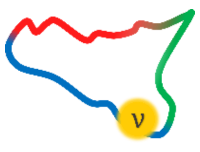Speaker
Description
JUNO (Jiangmen Underground Neutrino Observatory) is a neutrino experiment under construction in China. It will be the largest liquid scintillator experiment, detecting neutrinos and anti-neutrinos by using 20 kton of organic liquid scintillator contained in an huge Acrylic vessel of 35 m diameter. The experiment will start the data-taking in 2024 with the main goal to determine the Neutrino Mass Ordering (NMO) [1].
Thanks to its very large mass, low backgrounds and unprecedented energy resolution JUNO will be a pioneering experiment in neutrino physics. JUNO will reach the sensitivity to NMO in six year of data-taking, but it will be potentially a powerful detector also for solar neutrinos.
Solar neutrinos are produced by nuclear reactions burning in the core of the Sun. The main mechanism of hydrogen burning in the Sun is the pp chain. Five reactions of this chain produce neutrinos (pp, pep, hep, $^8\mathrm{B}$, $^7\mathrm{Be}$). Instead a small fraction ($1\%$) of solar neutrinos comes from the CNO-cycle. Borexino, an experiment located in Laboratori Nationali del Gran Sasso, performed the best measurement of the pp-chain neutrinos currently available [2] and the first measurement ever of the CNO-cycle neutrinos [3]. However, some questions remain open for solar physics, which would require an improved measurement of the solar neutrino flux, for example the so-called “solar metallicity problem”.
Radioactivity is the main background for a solar neutrino flux measurement. The radioactive backgrounds in JUNO will be due to the natural isotopes belonging to the $^{238}\mathrm{U}$ and $^{232}\mathrm{Th}$ chains and to $^{40}\mathrm{K}$, but also to the anthropogenic isotope Kr, and the cosmogenic ones, such as produced by residual cosmic muons interacting with of the liquid scintillator.
I will present a Monte-Carlo study of the sensitivity of JUNO to $^7\mathrm{Be}$, pep and CNO solar neutrinos as function of different radiopurity scenarios and duration of the data-taking.
[1] “JUNO physics and detector”. In: Progress in Particle and Nuclear Physics 123 (2022), p. 103927. issn: 0146-6410. doi: https://doi.org/10.1016/j.ppnp.2021.103927.
[2] M. Agostini et al. (Borexino collaboration). “Comprehensive measurement of pp-chain solar neutrinos”. In: Nature 562 (2018), pp. 505–510. doi: https://doi.org/10.1038/s41586-018-0624-y.
M. Agostini et al. (Borexino collaboration). “Experimental evidence of neutrinos produced in the CNO fusion cycle in the Sun”. In: Nature 587 (2020), p. 577. doi: https://doi.org/10.1038/s41586-020-2934-0.

